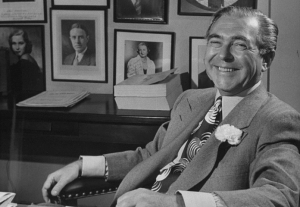Did Steve Hannagan Help Standard Oil Oppose
Mexico’s Expropriation of Foreign Oil Companies?
The Blog author has received a question: “Could we confirm if Steve Hannagan was in charge of a campaign on behalf of the Standard Oil Corporation in 1938 following the expropriation of their assets in Mexico?” After researching this question, I cannot conclusively answer it; however, there is some history in Wikipedia that may be helpful.[1]
The expropriation of Standard Oil’s assets in Mexico took place following an ongoing dispute between the Petroleum Workers Union of Mexico and all foreign oil companies operating in Mexico at the time. The dispute started on August 16, 1935, when the Petroleum Union presented the companies with a demand for payment of 65 million pesos to compensate them for below-market wages and benefits. The oil companies refused and counter offered with 14 million pesos. The dispute went to the Arbitration Board, which sided with the Union.
After several years with no action by the companies on the ruling of the Arbitration Board, the Union issued a demand to the foreign oil companies on November 3, 1937, to sign the agreement. By May 17,1938, with the issue still unsettled, the Union called for a strike that began on May 28, 1938.
On June 9, 1938, following the advice of the President of Mexico, the Union lifted the strike. He counselled the Union leaders to present their case to the General Arbitration and Conciliation Board. The Board formed a commission of financial experts who investigated the petroleum companies’ finances and concluded that their profits easily permitted them to cover the demands of the workers. The Board ordered the oil companies to pay 26 million pesos for wages and benefits to the workers. However, the oil companies’ management claimed that the amount of the payment would bankrupt them, and they again refused to pay the judgement.
Despite the Arbitration Board’s order to make payment, the companies continued to ignore the Board’s order; and by December 8, 1938, management began hiring new employees to replace Union workers. On December 18, the Arbitration Board made a formal declaration in favor of the Union by means of a “laudo” (binding judgment in arbitration) which demanded that the companies fulfil the requirements of the petitions and pay 26 million pesos in lost salaries. The petroleum companies filed a lawsuit on January 8, 1939, to protect their property from the Arbitration Board’s declaration. The court subsequently rendered their decision on March 1, giving the companies until March 7 to pay the 26 million pesos penalty.
The refusal of the companies to comply with the court rulings led to the President nationalizing the U.S. and Anglo–Dutch oil operating companies on March 18, 1939. On June 7, 1939, President Cárdenas issued a decree creating PEMEX (Petróleos Mexicanos) with exclusive rights over exploration, extraction, refining, and commercialization of oil in Mexico. On June 20, PEMEX started operations and took over the assets of the foreign oil companies.
The oil companies retaliated with a public relations campaign against Mexico, urging people to stop buying Mexican goods and lobbying to embargo U.S. technology to Mexico. Many foreign governments closed their markets to Mexican oil, hoping that PEMEX would drown in its own oil. U.S. oil companies did not get any support from the U.S. government either because of President Franklin D. Roosevelt’s Good Neighbor Policy to recalibrate U.S.-Latin American relations.

Standard Oil Refinery – Mexico[2]
So back to the question of whether Steve Hannagan ran the Standard Oil press campaign opposing the expropriation of their operations by the Mexican government. The question is difficult to answer for two reasons. Firstly, Hannagan’s files were destroyed after his death when they were incinerated by a cleaning crew who misidentified the files as trash. Secondly, the files of Standard Oil on this matter are unavailable.
Endnote
- The discussion paraphrases an article found in Wikipedia; “Mexican Oil Expropriation”; https://en.wikipedia.org/wiki/Mexican_oil_expropriation. ↑
- Sanchez, Karina Cerino; Historia de la Industria Petrolera en Mexico; (Retrieved August 18, 2020): https://www.bing.com/images/search?view=detailV2&ccid=F8E8GrWv&id=6006C2B7DE04E81FE01900F992C7B092D22882B8&thid=OIP.F8E8GrWvtAGXI6MPZnPowQHaFo&mediaurl=https%3a%2f%2fi.pinimg.com%2foriginals%2f82%2f9a%2fc3%2f829ac3eea2130c93c91bf02d7980f37f.jpg&exph=954&expw=1255&q=standard+oil+mexico+refineries&simid=608030295307194020&ck=5585B6F40931F959D10F48F7FD560E71&selectedIndex=8&FORM=IRPRST&ajaxhist=0 ↑


